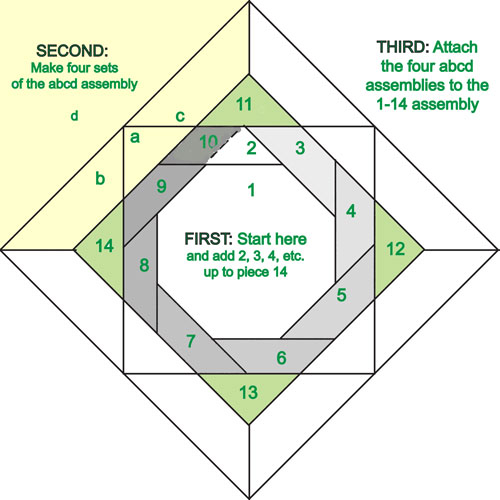Why does a middle-aged woman spend her days stitch fabric cartoons of happy-faced extinct reptiles and humanoid females in pink? Or appliqué the Tooth Fairy on a pillowcase? Or tackle—and finish—a queen-sized wedding ring quilt?
Love, that's what. Love is the currency of quilting.
Quilting tradition is all about family. Mother teaches sewing to daughter; daughter, with rotary cutter, quick-construction techniques, and machine quilting, works up quilts faster than her grandmother ever dreamed, and then gives them away to family, friends, and charities. In return, she feels a glow from expressing the love she feels, and sometimes—not always—from the gratitude she gets in return. So is the quilter paid.
Quilt buyers assume that since love is free, it has no monetary value. They accordingly value a quilter's time at zero dollars, and in gauging a quilt's worth, pay only a modest multiple of the cost of the fabric. It's always been that way. In 1930, the Quilt Index says, 196 people paid 25 cents apiece to put their names on a quilt that sold for $40 as a fund raiser. The pattern was Melon Patch.
In the 1860s, a church women's group quilted a full-size quilt for $2.00; Ruth Finley, who wrote about it in Old Patchwork Quilts: And the Women Who Made Them, figured that as a penny an hour. In June 2013, if you use the Consumer Price Index as a gauge, that amounted to 16 cents an hour. If that seems unreasonably low, just take a look at the quilt selling prices on eBay.
We all know that to sell a quilt usually means earning less than minimum wage. We should refuse to sell at fire-sale prices. We don't, though; we make quilts the way an artist paints canvas—again, for love, but this time for the love of creativity.
Now, we use our creativity to decorate our homes. Appalachian frontier women would hang a cloth on the wall and hang their knickknacks on the cloth. We order marble kitchen counters and koi-pond kits, consulting not Mom but Martha Stewart. Daughters no longer learn to sew; they learn to buy.
In short, it is a golden age for quilt collectors. Today, even exquisite antique quilts go for a few thousand dollars.
Tomorrow will be different.
Love, that's what. Love is the currency of quilting.
Quilting tradition is all about family. Mother teaches sewing to daughter; daughter, with rotary cutter, quick-construction techniques, and machine quilting, works up quilts faster than her grandmother ever dreamed, and then gives them away to family, friends, and charities. In return, she feels a glow from expressing the love she feels, and sometimes—not always—from the gratitude she gets in return. So is the quilter paid.
Quilt buyers assume that since love is free, it has no monetary value. They accordingly value a quilter's time at zero dollars, and in gauging a quilt's worth, pay only a modest multiple of the cost of the fabric. It's always been that way. In 1930, the Quilt Index says, 196 people paid 25 cents apiece to put their names on a quilt that sold for $40 as a fund raiser. The pattern was Melon Patch.
In the 1860s, a church women's group quilted a full-size quilt for $2.00; Ruth Finley, who wrote about it in Old Patchwork Quilts: And the Women Who Made Them, figured that as a penny an hour. In June 2013, if you use the Consumer Price Index as a gauge, that amounted to 16 cents an hour. If that seems unreasonably low, just take a look at the quilt selling prices on eBay.
We all know that to sell a quilt usually means earning less than minimum wage. We should refuse to sell at fire-sale prices. We don't, though; we make quilts the way an artist paints canvas—again, for love, but this time for the love of creativity.
Now, we use our creativity to decorate our homes. Appalachian frontier women would hang a cloth on the wall and hang their knickknacks on the cloth. We order marble kitchen counters and koi-pond kits, consulting not Mom but Martha Stewart. Daughters no longer learn to sew; they learn to buy.
In short, it is a golden age for quilt collectors. Today, even exquisite antique quilts go for a few thousand dollars.
Tomorrow will be different.








